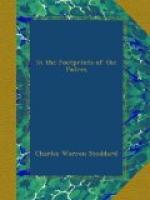Off the Brazilian coast a head-wind forced the ship to tack repeatedly; she was sometimes so near the land that people could be seen moving, like black dots, along the shore. Native fishermen, mounted upon the high seats of their catamarans—the frailest rafts,—drifted within hailing distance; and over night the brave ship was within almost speaking distance of Pernambuco. The lights of the city were like a bed of glowworms,—but the small, sad boy was blown off into the sea again, for his hour had not yet come.
Here is the last entry I shall weary you with, for I would not abuse your patience:
“APRIL 5, 1857.—I was awoke this morning by the noise the pilot made in getting on board. At ten o’clock the steam-tug Hercules took us in tow. We had beautiful views of the shore [God knows how beautiful they were in his eyes!], and at three o’clock we were at the Astor House, with Captain and Mrs. Cresey, Mr. Connor, and the Stoddard boys—all of the Flying Cloud,—where we retired to soft beds to spend the night.”
There is a plaintive touch in that reference to soft beds after three months in the straight and narrow bunk of a ship. And there is more pathos in all those childish pages than you wot of; for, alas and alas! I am the sole survivor,—I was that small, sad boy; and I alone am left to tell the tale.
A BIT OF OLD CHINA
“It is but a step from Confucius to confusion,” said I, in a brief discussion of the Chinese question. “Then let us take it by all means,” replied the artist, who had been an indulgent listener for at least ten minutes. We were strolling upon the verge of the Chinese Quarter in San Francisco, and, turning aside from one of the chief thoroughfares of the city, we plunged into the busiest portion of Chinatown. From our standpoint—the corner of Kearny and Sacramento Streets—we got the most favorable view of our Mongolian neighbors. Here is a goodly number of merchant gentlemen of wealth and station, comfortably, if not elegantly, housed on two sides of a street that climbs a low hill quite in the manner of a tea-box landscape.
A few of these gentlemen lodge on the upper floors of their business houses, with Chinese wives, and quaint, old-fashioned children gaudily dressed, looking like little idols, chatting glibly with one another, and gracefully gesticulating with hands of exquisite slenderness. Confucius, in his infancy, may have been like one of the least of these. There are white draymen and porters in the employ of these shrewd and civil merchants, and the outward appearance of traffic, as conducted in the immediate vicinity, is rather American than otherwise.
Farther up the hill, on Dupont Street, from California to Pacific Streets, the five blocks are almost monopolized by the Chinese. There is, at first, a sprinkling of small shops in the hands of Jews and Gentiles, and a mingling of Chinese bazaars of the half-caste type, where American and English goods are exposed in the show windows; but as we pass on the Asiatic element increases, and finally every trace of alien produce is withdrawn from the shelves and counters.




